Overview
Lemons are small to medium fruits, averaging 5 to 12 centimeters in length, and have an ovate to oblong shape with pointed, curved ends. The rind, also known as the peel, is generally pale to bright yellow and bears many small, fragrant oil glands, creating a textured and glossy, finely pitted surface. Underneath the rind, there is a semi-thin, white pith with a spongy, cotton-like consistency, encasing 8 to 11 segments of soft, tender flesh.
The pale-yellow flesh is comprised of translucent sacs filled with juice and pulp, and some Lemon varieties contain a few seeds, while other cultivars are found seedless. Lemons will vary in texture and flavor, depending on the variety, but the fruits are known for their complex, bright, and acidic flavors with floral, sweet-tart, and tangy undertones. Here are some of the lemon varieties that are grown around the world.
Types/Varieties of Lemons
1. Eureka Lemons

The Eureka lemon tree is an evergreen tree that produces pink-fleshed lemon fruits all year. Eureka lemons usually start to bear fruit in their 4th year. However, it is fairly common to see fruits on some Eureka Lemon within the second or third year.
Eureka lemons are large, averaging 5 centimeters in diameter, with an oblong shape. They have a vibrant yellow skin with sunken oil glands, resulting in a textured surface. The rind is full of volatile oils, providing an intense citrus aroma. Eureka lemons have a pronounced blossom-end knob, called a mammilla, and a medium-thick white pith. The juicy, yellow flesh contains few to no seeds and offers a tart and acidic flavor.
Eureka lemons may be used in wide range of applications, from sweet to savory. They can be made into marmalades or used in baked goods, such as lemon meringue pie, and their zest can be infused into oils. Both its zest and juice can be used in cocktails, syrups, marinades, and dressings. Pair with other citrus, poultry and seafood, tea, or fresh fruits and vegetables. Store at room temperature for up to one week, or refrigerate to extend shelf life up to one month.
2. Lisbon Lemons

Lisbon lemons are medium-sized, oblong citrus fruits with a rounded stem end and very pronounced mammilla, or nipple, on the opposite end. The medium-thick rind is smooth and bright yellow when mature. It is finely pitted with oil glands that when scratched or rubbed offer a citrusy aroma. The pale-yellow flesh has few to no seed and is very juicy and acidic. Lisbon lemons grow on both dwarf and tall-statured trees, hidden under dense, evergreen foliage.
Lisbon lemons are most often used fresh, for their juice and zest. Whole lemons can be sliced lengthwise into rounds or quartered and used as a garnish for beverages or dishes, or for topping poultry or fish before baking. The acidic juice is used to tenderize meats and fish, like in a ceviche. Use the juice for marinades or in place of vinegar in salad dressings. It can be used for desserts from custards to sorbets. Zest from the rind can be used for flavoring meats, sauces and desserts. Store Lisbon lemons at room temperature for up to a week; for longer storage, refrigerate for up to two weeks. Juice and zest can be frozen to preserve.
3. Meyer Lemons

Meyer lemons are a small to medium variety, averaging 6 to 8 centimetres in diameter, and have a round to oval shape. The peel is thin, smooth, glossy, golden yellow to orange, and aromatic, lightly textured with glands that release essential oils. Underneath the peel, there is a thin and spongy white pith enveloping yellow-orange flesh, divided into 9 to 10 segments by white membranes. The flesh is also soft, tender, and aqueous, encasing a few seeds or being found seedless. Meyer lemons are highly fragrant and emit a bright, herbal scent with subtle spice-filled notes. The fruits also contain low acidity and a high sugar content, developing a sweet, zesty flavor with floral undertones.
Meyer lemons contain low acidity, developing a sweet juice, zest, and flesh suitable for both fresh and cooked applications. When raw, Meyer lemons can be chopped and tossed into dips, sliced thinly and added to salads, or infused into dressings, olive oils, and vinegar. Meyer lemons are also used for their fragrant zest and juice, which is sweeter and more floral than a eureka or lisbon lemon. The lemons can be sliced thinly and used as a topping over pizza, layered under meats and roasted to develop a caramelized texture, zested into pasta, juiced for cocktails and non-alcoholic beverages, or used to flavor soups and stews.
4. ‘Lemonade’ Lemons

Lemonade fruits are a small to medium citrus, averaging 7 to 10 centimeters in diameter, and have a round to oval shape. The rind is glossy, smooth, and lightly textured, covered in small oil glands that release an aromatic, bright citrus scent. When young, the rind is dark green, ripening to a bright yellow with maturity, and underneath the surface, there is a thin layer of semi-sweet, white, spongy pith. The flesh is aqueous, soft, and golden yellow, divided into 9 to 11 segments by thin membranes, and the fruits may either be seedless or contain a few ivory seeds. Lemonade fruits have low acidity, allowing the natural sugars found in the flesh to create a refreshing, sweet, and tangy flavor without the sour taste commonly associated with lemons.
Lemonade fruits have a sweet, subtly tangy flavor that can be utilized in a wide variety of fresh and cooked applications. The fruit’s rind can be sliced or peeled, and the flesh can be segmented, consumed straight, out-of-hand. The segmented flesh can also be chopped and mixed into fruit bowls, blended into smoothies, juiced for fresh lemonade, squeezed over guacamole, or used to flavor cocktails as a twist on traditional lemons. In addition to fresh preparations, Lemonade fruit’s juice and zest can be incorporated into baked goods, cheesecake, butter, or meringue, or it can be used to flavor vinaigrettes and sauces.
Also Read: Types of Mushroom
5. Zest Lemons
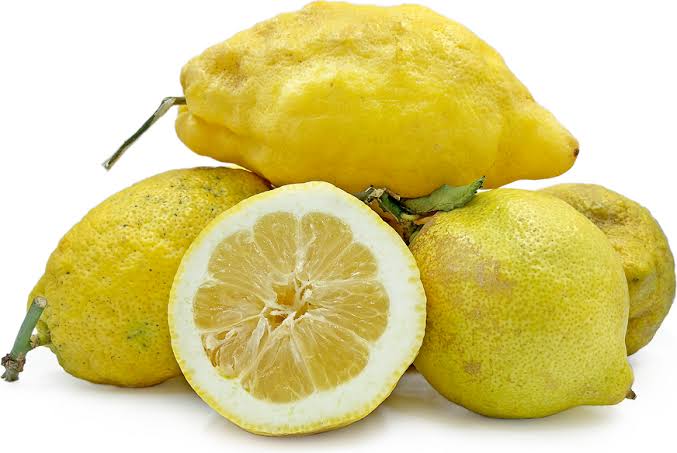
Zest lemons varieties are larger than common lemons and have an elongated shape. Some varieties, like the cedro, can be more round or asymmetrical. Their size can range anywhere from 10 to 30 centimeters long and up to 10 centimeters wide. Zest lemons have bright yellow rinds with the occasional remnants of green. The medium-thick skin is often bumpy or knobby and may have vertical ridges running down the length of the fruit. The oil glands, known as lenticels, are deep and emit a very intense citrus aroma. Beneath the zest is a soft, spongy, white pith called albedo. In lemons, this is bitter and is generally removed before using. In Zest lemons, it has a delicately sweet flavor and is one of the main portions of the fruit used. This section makes up 70% or more of the fruit.
The most popular use for Zest lemons is for making candied citron. The rind and pith are removed from the pulp and soaked in a sugar water and then dried. Candied Zest lemon is an important ingredient in the holiday panettone cake and other desserts. Zest lemons are also used to flavor liqueurs like limoncello.
6. Ponderosa Lemons

Ponderosa lemons are a medium to large citrus variety, averaging ten centimeters in diameter and two pounds in eight, but the oval to oblong fruits can grow up to five pounds in weight and have a short neck with curved, rounded ends. The rind is smooth, firm, bright yellow-green, and textured, covered in bumps, ribbing, and prominent oil glands releasing fragrant essential oils. Underneath the surface, there is a semi-thick, white, and spongy pith encasing the pale green to yellow flesh. The aqueous flesh is divided into 10 to 13 segments and has a soft consistency, filled with many cream-colored, hard seeds. Ponderosa lemons are highly acidic, developing a bright floral, fruity, and tangy flavor mixed with a subtle sweetness.
Ponderosa lemons have a similar flavor profile to common table lemons and can be used as a lemon substitute in raw and cooked applications. Many of the large fruits contain adequate juice content that can be pressed and used for salad dressings, sauces, and as a finishing element over grain bowls, ceviche, roasted meats, and stir-fries. The juice can also be stirred into lemonades, cocktails, and sparkling beverages. In addition to the juice, the rind can be zested into vegetables, pasta, and seafood, the whole fruit preserved in salt for extended use, or the fruits can be used as a flavoring for desserts, syrups, and baked goods.
7. Femminello Ovale Lemons
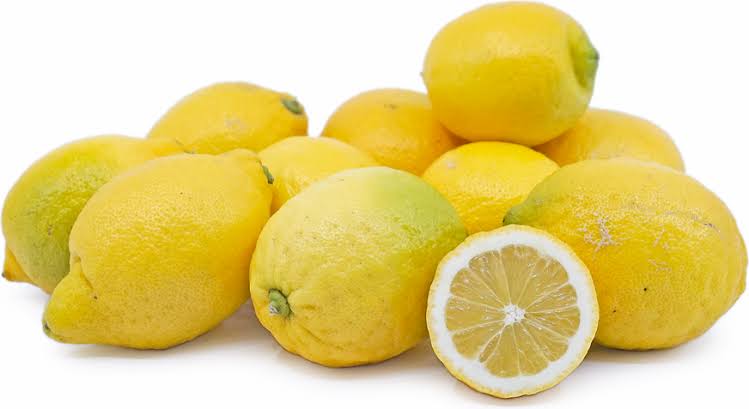
Femminello Ovale lemons (Citrus × limon ‘Femminello’) are a variety of lemon that comes from Italy. In fact, ‘Femminello’ cultivars are the most popular kinds of lemons that grow in Italy. Lemons from the Femminello lemon trees have an oval shape with a rounded bottom. The medium-thick yellow rind is moderately smooth and finely pitted. Compared to some US varieties of lemons, Femminello Ovale lemons have a much tarter taste. Femminello lemons are also a larger variety of lemon when compared to different kinds of lemons such as Eureka and Lisbon.
Femminello Ovale lemons pair well with spices such as cinnamon, cloves, ginger, and red pepper flakes, herbs such a bay leaves, oregano, rosemary, and thyme, meats including poultry, turkey, fish, other seafood, blueberries, coconut, bell peppers, dark chocolate, and cheeses such as parmesan, mozzarella, and gruyere. Whole, unwashed Ponderosa lemons will keep 5 to 6 days when stored at room temperature and 1 to 14 days when stored in a plastic bag in the refrigerator.
8. Siracusa Lemon

The Siracusa lemon is characterized by a high juice content and abundance of oil glands in the skin, as well as the high quality of its essential oils. The Siracusan variety of lemon is called a femminello because of the fertility of the plant, which flowers all year round: the primofiore (literally, “first flower”) matures from October 1st, has an elliptical shape, skin and flesh which varies from light green to lemon-yellow, and lemon-yellow juice; the bianchetto ripens from April 15th, is ovoid-elliptical, with light yellow skin, yellow flesh and lemon-yellow juice; the verdello matures from July 1st, is an spheroid elliptical shape, light green skin, and lemon-yellow flesh and juice.
Siracusa lemons can also be incorporated into cookies, cakes, scones, macarons, muffins, and tarts, simmered into lemon curd, or the peels can be candied and eaten as a sweet treat. In addition to fresh and cooked applications, the lemons can be scored, packed in salt, and preserved for extended use. Siracusa lemons pair well with herbs such as mint, thyme, basil, parsley, and rosemary, meats such as poultry, turkey, and fish, other seafood, potatoes, asparagus, broccoli, peas, cranberries, and parmesan. Whole Siracusa lemons will keep 5 to 10 days when stored in a plastic bag in the refrigerator’s crisper drawer. The juice can also be frozen for up to 6 months.
Also Read: Types of Kale Varieties
9. Verna Lemons

The Lemon Verna comes from Spain, it’s well known to be a very durable fruit in the tree and for being fluorescent. The period of the first harvest last a very long time, it flourishes in spring and is being picked up in a scaled way from February to July, leaving the period of August to September for the second harvest to be recollected for the next summer.
The size of the lemon Verna stands out for being particularly big; it has a slightly pronounced neck in its base and a big apical mamelon. Its rind is big and wrinkled. Its colour stands out for being of very intense yellow. It has very few pips in its inside.The lemon Verna has a big quantity of uses, culinary speaking as well as medically. It can be squeezed to maximize its flavour on foods or by adding a few slices to change the taste of meals.
10. Genoa Lemons

The Genoa Lemon is an Italian Lemon that is similar to the Eureka Lemon. It is popular for its cold hardiness, dense foliage and vigorous growth. This lemon tree grows in a shrub-like form; it grows wide rather than tall, making it quite easy to harvest these delicious lemons. Its size also makes it ideal for container planting.
The fruits on this robust shrub ripen throughout the year on branches that are less thorny than some lemon varieties. The brightly colored peel is very high in lemon oil making it great for use in flavorings. The juice is perfect for marinades and drinks.
11. Volkamer Lemons

Volkamer lemon (Citrus volkameriana) is a hybrid of a mandarin orange (C. reticulata) and a citron (C. medica), with the citron being the pollen parent and the mandarin being the seed parent. The fruit is moderately large (around the size of an orange), seedy, round and slightly elongated, and yellow-orange in color. The flavor is not as unpleasant as one might expect. It ripens from winter to early spring.
The tree is densely branched and high-yielding, often weighed down because of the fruits. The leaves are elliptical in shape and the flowers have five white petals. It is hardy to USDA zone 9.The tree is fast-growing and adaptable to many soil conditions. It is not susceptible to tristeza virus, exocortis, or xyloporosis viroids, but is susceptible to citrus nematode and phytophthora root rot.
12. Santa Teresa Lemons
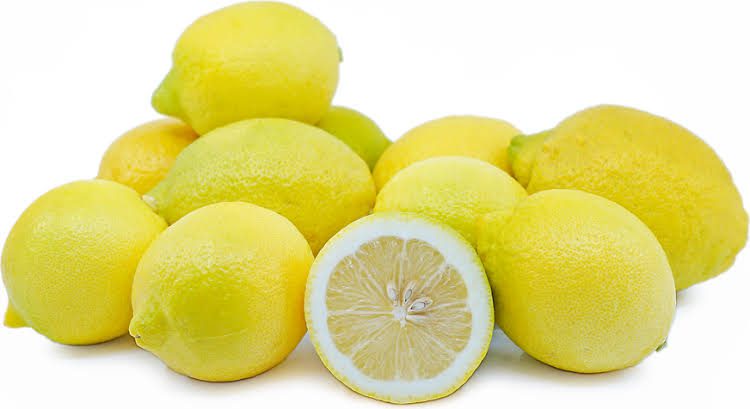
Santa Teresa lemons are large, with a round, elongated shape. They are rounded with at the stem end and taper to a point, displaying the characteristic, prominent mammilla. The medium thick rinds are bright yellow and have deep oil glands that release a distinctly intense citrus aroma. The pale-yellow flesh is very juicy and contains few seeds. Santa Teresa lemons have a rich lemon flavor that is high in acidity with a slight sweetness.
The zest, rind and juice of the Santa Teresa lemons are used for both raw and cooked applications. In Italy, the zest is traditionally paired with anchovies or swordfish and the juice is often used as a substitute for vinegar in dressings and marinades. The fragrant peel is candied in strips or chunks and sprinkled with sugar. The zest can be added to soups, sauces, fish, and poultry dishes, and is baked into cakes, muffins and scones. The juice can be used for beverages and frozen desserts. Santa Teresa lemons store well and can be kept at room temperature for up to two weeks. Refrigerate them for up to a month.
Also Read: Different Types of Bananas
13. Sorrento Lemons

Sorrento lemons are a medium to large variety with an oval shape, each end tapering to a point. The stem end may have a more prominent neck, and the opposite end will always display the typical, protruding mammilla. The highly fragrant rind is thick and somewhat bumpy, with visible oil glands. The translucent yellow pulp is aromatic, very juicy, and has very few to no seeds. Sorrento lemons have a somewhat tart, acidic flavor without any bitterness.
The large, Sorrento lemons are used for their zest, rind and juice. Most often, Sorrento lemons are used for making limoncello. They are also halved, salted and preserved for later use. The fragrant lemons are used to make jams, preserves and custards. The rind and pith are used to make candied lemon peel, or used to infuse vinegars and oils. Halved or quartered Sorrento lemons can be roasted alongside meats, fish or vegetables. The aromatic zest will add a tangy citrus flavor to anything from baked goods to savory dishes. In Italy, it is often added as a finishing touch to risotto or pasta dishes. The juice can be used for marinades, beverages, sorbets, and other desserts. Store Sorrento lemons at room temperature for up to a week and refrigerate for longer shelf life.
14. Perrine Lemons
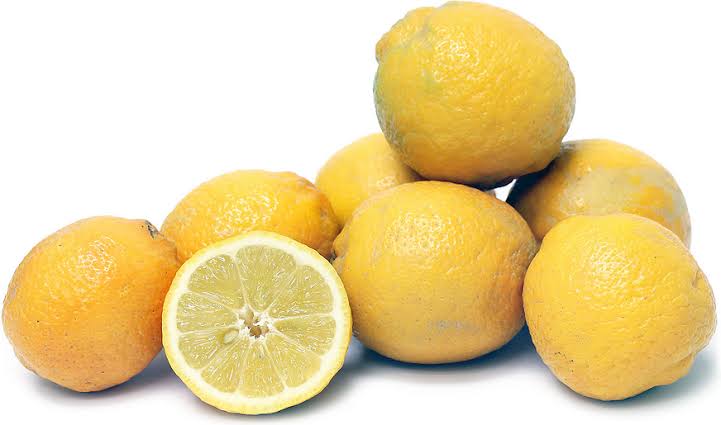
Perrine lemons are small, much closer in size to a lime, measuring between 4 and 5 centimeters in diameter. They have a yellow rind that may still have traces of pale green. They have an elongated shape like that of a traditional lemon, only slightly more rounded. The rinds are thin with a pale-yellow pulp divided into 12 segments. Fruits have anywhere from 3 to 10 seeds. Having a higher acidity, closer to that of a traditional lemon, juicy Perrine lemons offer a lime-like tart flavor.
Perrine lemons can be used in any recipe calling for citrus, whether it is lemons or limes. The hybrid fruit’s juice will tenderize meats in marinades and denature the fish and shellfish in ceviche. It can be used in beverages, desserts, dressings, or added to dishes for additional acidity. Make a granita or sorbet with Perrine lemon juice. Store Perrine lemons at room temperature for up to a week, refrigerate for up to a month.
15. Indian Lemon

Indian lemons are round to oval, averaging 5-10 centimeters in diameter. The thin, slightly bumpy, outer skin has prominent oil glands and is green when unripe and transforms to a bright yellow when mature. The flesh is succulent and vibrant yellow with 8-10 segments and a few, white, inedible seeds. Indian lemons are juicy, semi-sweet, and mild with low acidity.
Indian lemons are typically used in fresh preparations to add sweet and sour flavors and balance out heat in dishes. They can be squeezed and used to dress Western-styled salads in northern India, which are comprised of raw onion, sliced tomatoes, green chiles, and cucumbers. The juice can also be used to make sodas and nimbu pani, or Indian lemonade. Indian lemons are commonly sliced and used to make pickled lemon, which is a mixture of sliced lemon, salt, pepper, chiles, and carom seeds and is left to ferment in a jar for several weeks before consuming as a side dish. Indian lemons pair well with herbs such as lavender, mint, cilantro, basil, and lemongrass, aromatics such as garlic, onion, ginger, and fennel, white wine, sesame, curry leaf, turmeric, and fruits such as strawberry and cucumber. Indian lemons will keep up to two weeks when stored in the refrigerator.
Also Read: Types of Pineapples
16. Brazilian Baboon Lemon

Brazilian lemon has a very intense yellow rind and flesh. The flavor is acidic with almost a hint of lime. Tree is vigorous with large green leaves. Both tree and fruit are beautiful. Its rind and pulp are used in the preparation of several types of sauces, such as barbeque and pasta sauce.
In northern Italy, Baboon lemons are used to make a famous soda called cedrata. Its zest and thick pith is used to make a wheatberry and ricotta cake called pizza grana, often made around Easter-time. Store Zest lemons at room temperature for up to a week. Refrigerate for up to three weeks.
17. Interdonato Lemons

Interdonato lemon is a large fruit with an oblong-cylindrical shape. The fruit is yellow at maturity with few seeds. Its rind is thin, shiny and very smooth. The juice from interdonato has some flavor and often highly acid with slight bitterness. Interdonato tree produces mainly in fall and early winter, it generally has large leaves and somewhat citron-like, with round-pointed blades, undulate margins, and short wingless petioles.
Interdonato lemon pair well with meats such as lamb, poultry, and pork, seafood, almonds, artichokes, olives, tomatoes, spices such as cumin, paprika, saffron, and cinnamon, chickpeas, and sesame seeds. Whole Interdonato lemon will keep 1 to 2 weeks when stored at room temperature and up to six weeks in the refrigerator.
Also Read: Varieties of Citrus Fruits
18. Buddha’s Hand Lemons

Buddha’s Hand lemon/citron widely varies in size, shape, and appearance, depending on growing conditions and specific type. The fruit begins small with an oval to oblong shape and is a purple-brown hue. As it matures, the fruit transitions to golden yellow, and the non-stem end separates and extends into elongated, finger-like segments. The fingers can be broadly spread in all directions, or they can be tightly layered and closed. The rind of the citron is textured, bumpy, and covered in small oil glands that release an aromatic scent reminiscent of lemon and lavender. The rind also has a bitter-sweet, citrus-forward flavor. Underneath the rind, the flesh is generally void of juice, seeds, and pulp and only contains a thick and spongy, white pith that bears a sweet flavor. Buddha’s Hand citron has a bitter-sweet, bright and floral flavor that is primarily used as a zest for flavoring sweet and savory applications.
Buddha’s Hand citron contains no pulp or juice and is utilized for its fragrant, bitter-sweet rind and sweet pith. The rind is used as zest and can be mixed into salad dressings, pancake batter, baked goods, crème brulee, sprinkled over seafood, or incorporated into other savory dishes such as pasta. The flavor of Buddha’s Hand citron is widely versatile and can also be used in any recipe calling for lemon zest. In addition to zesting, the rind and pith can be sliced and used to infuse liquors, olive oils, sugars, and salts. The chopped pith pieces can also be cooked into marmalade and simple syrups, candied for a chewy sweet snack, or used to flavor tea and butter.
19. Persian Sweet Lemons

Persian Sweet lemons are medium-sized round fruit, averaging 5 centimeters in diameter, with slightly yellowish-green skin that matures to a warm yellow. The pale yellow flesh is highly fragrant with hints of rose, and houses several seeds. The taste is sweet, more like that of an orange, though within a few hours after cutting, the juice can take on a bitter flavor, similar to grapefruit juice. The thin rind contains essential oils and emits a pleasant, honeyed aroma when rubbed.
Persian Sweet lemons are used in raw and cooked applications. Their sweet flavor is not the result of higher sugar content, but rather a lack of acidity. Enjoy raw Persian Sweet lemons immediately after opening or juicing, as the flavor can become somewhat bitter once exposed to air. The lemon juice can be used in salad dressings and marinades, soups or broths, and in beverages.
20. Rough Lemons

Rough lemon is a medium-sized fruit of highly variable form but often oblate to elliptic-oblong. It typically has a deeply pitted and rough or bumpy surface. Its flesh color is light yellow to pale orange. It also has a medium-thick rind and has numerous seeds. Its juice has some flavor but moderately acidic.
Beyond flavoring culinary preparations, rough lemons can be sliced and stirred into water, lemonade, and cocktails, sweetened with sugar, honey, or agave for a balanced taste. They can also add mild acidity into mixed drinks and sparkling beverages.
Rough lemons pair well with herbs such as lavender, rosemary, thyme, and marjoram, meats including poultry, turkey, pork, and fish, other seafood, honey, and fruits such as blueberries, strawberries, coconut, and peaches. Whole, rough lemon will keep up to one month when stored in a plastic bag in the refrigerator.
21. Amalfi Coast Lemons
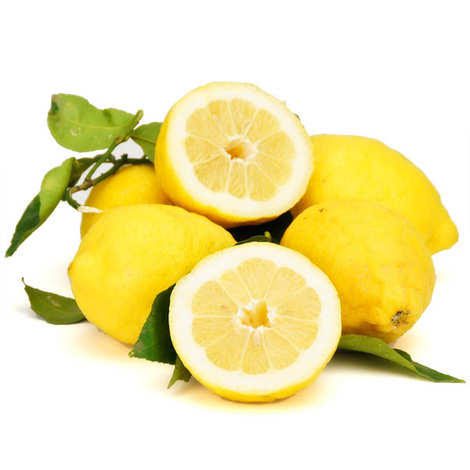
Amalfi Coast lemons are a traditional lemon variety (Citus limon) from the Amalfi Coast region of Italy. This variety was originally developed as a cross between small, local lemons and bitter oranges. They are also called Sfusato Amalfitano in Italian.
Amalfi Coast lemons are an impressive lemon variety. The Italian name—Sfusato Amalfitano—refers to the fruit’s tapered shape, distinctively different than the rounder varieties of lemons grown elsewhere in Italy. Amalfi Coast lemons are also larger on average than other varieties, with each fruit weighing at least 100 grams. The medium to thick skin is a pale yellow color. The rind has an especially intense lemon aroma because of the essential oils it contains. Inside, the flesh is acidic, semi-sweet, and very juicy. Amalfi Coast lemons tend to contain few seeds.
Amalfi Coast lemons are traditionally used to make limoncello, are served on the side of salads and meals as a dressing, or even served with coffee. They are particularly good to use for cooking because of their flavor and lack of seeds. Pair with fish for a classic taste. The zest and flesh are useful in baking and are key bases in several desserts from the region as well. Lemons store best in plastic bags in the refrigerator, and will keep for up to a month.
22. Bergamotto Lemons
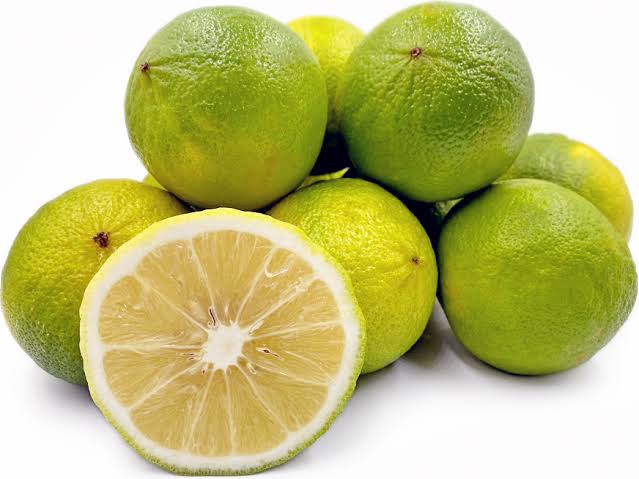
Bergamotto lemons are round and a bit larger than an orange, with a slight pear shape. The green skin of the Bergamotto lemon is thin and very aromatic, which is a result of high amounts of a compound called limonene present in the peel. The skin slowly changes from lime green to a greenish yellow color towards the end of the season. The flesh of the Bergamotto lemon resembles that of a grapefruit, and has a fragrant aroma. The taste of the juice is bitter, acidic, and somewhat musty.
Bergamotto lemon is used in a wide variety of applications, from culinary to pharmaceutical. The fruit is squeezed for its sour-bitter juice, and the rind is zested or pressed for its intensely aromatic oils. Bergamotto lemon juice can be used to make sorbet, gelato, or a marinade for fish or poultry. The Italian citrus variety can be used in dressings, desserts, juices or other applications where lemon or lime juice is used. Keep Bergamotto lemon refrigerated for up to a month in the crisper drawer; fruit left at room temperature will not keep for more than a week.
Also Read: Difference Between True Fruit And False Fruit
23. Pink lemons
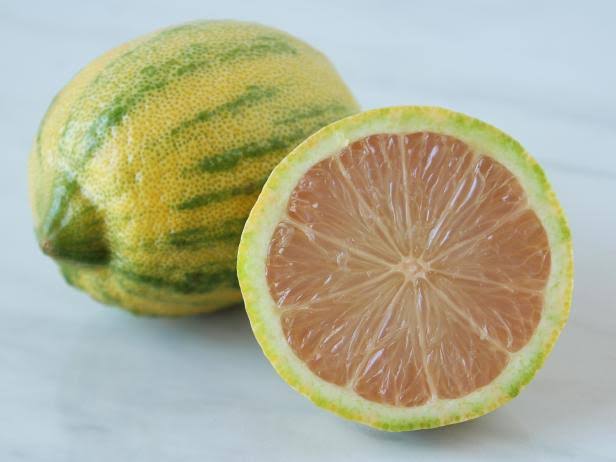
Pink lemons are small to medium fruits that have an oblong to oval, slightly tapered shape. The rind is thin, semi-rough, and covered in vertical, variegated green and white striping. Each green stripe is ridged, creating a textured surface, and as the fruits mature, they develop prominent oil glands while the striping fades. Underneath the surface, the flesh is blushed with a light pink, rosy hue and is tender, juicy, and succulent, being found seedless or containing a few seeds. When squeezed, the fruits will emit a clear juice despite the flesh being colored.
Pink lemons are aromatic, bearing a bright, citrus scent, and contain low acidity, creating a sweet, tangy, subtly tart, floral, and fruity flavor. Pink lemon trees also showcase variegated and glossy green and white ovate leaves and fragrant flowers, known among citrus enthusiasts as one of the most aromatic varieties.
Pink lemons have a sweet, tangy flavor well suited for flavoring culinary dishes, baked goods, and beverages. The lemons can be used in any recipe calling for common lemons and can be sliced and squeezed for their juice, adding bright flavors to seafood dishes, vegetables, curries, soups, and grain bowls. The juice is also frequently mixed into salad dressings, vinaigrettes, and sauces. In addition to savory dishes, Pink lemons are used for their juice and zest to flavor desserts and baked goods, including pies, cakes, scones, lemon bars, and tarts. The lemon’s juice can be frozen into popsicles, or slices can be candied as an edible garnish.
24. Marrakech Limonettas
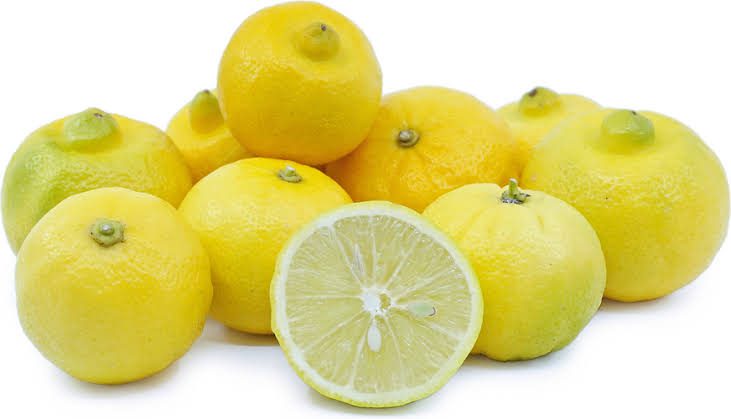
Marrakech Limonettas are small to medium fruits with a round to slightly flattened shape, and one side of the fruit bears a noticeable depression containing a central and distinct, pointed apex. The skin is thin, lightly ribbed, semi-glossy, bright yellow, and pebbled, covered in many small oil glands that release fragrant essential oils. Underneath the surface, the flesh is divided into 10 to 11 segments by thin, white membranes and is soft, aqueous, and pale yellow, encasing a few ivory seeds. Marrakech Limonettas are aromatic with a bright, floral scent and contain high acidity, developing a sour and tart, lemon-like taste.
Marrakech Limonettas are best suited as a flavoring agent and provide bitter, acidic notes to both fresh and cooked preparations. The fruits can be juiced and incorporated into sauces, or they can be cooked into marmalades, jellies, jams, and preserves. Marrakech Limonettas can also be preserved in salt as this method develops a sweeter, less bitter flavor. Once preserved, the fruits can be chopped and mixed into fish, chicken, or rice-based dishes, smashed over avocado toast, or sliced and mixed into salads. Preserved Marrakech Limonettas can also be blended into spreads and dips, chopped into salsas, or tossed into soups and stews.
Other Varities of lemons include:
- Yen Ben Lemons
- Assam Lemons
- Primofiori Lemons
- Villafranca Lemons